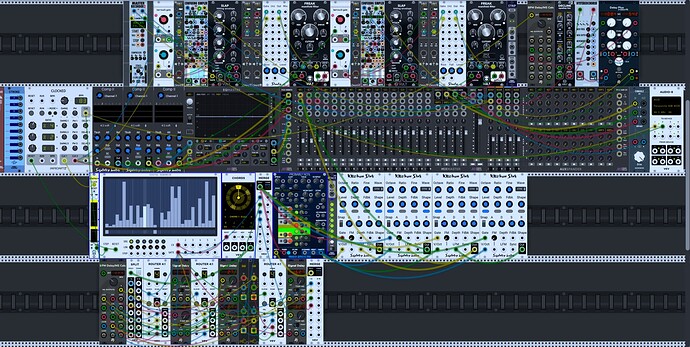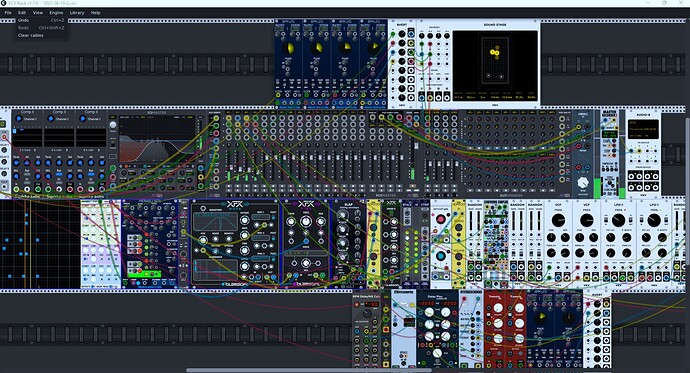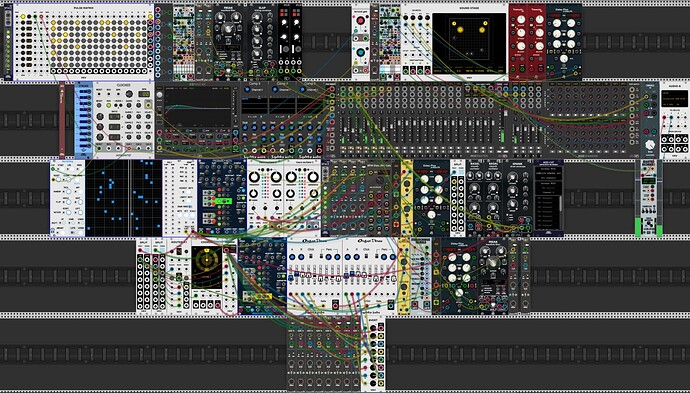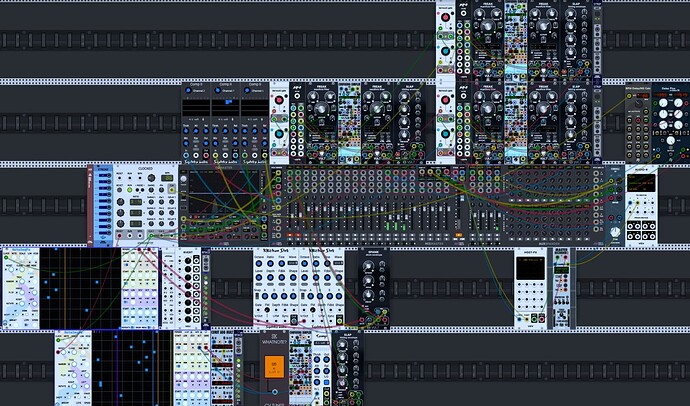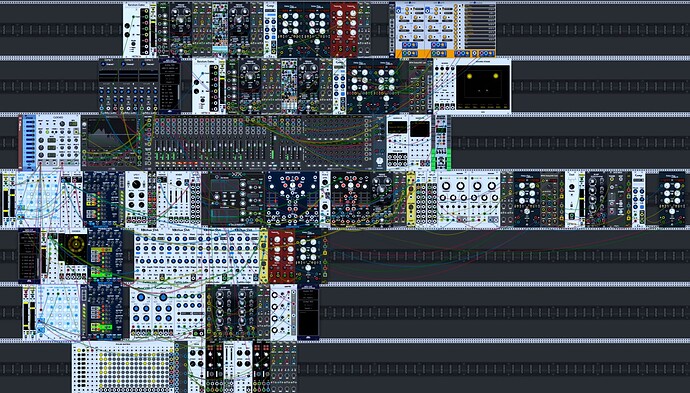The Blamsoft XFX Grunge in particular is also a real gem of a distortion module!
How do you get that module? I think I got the filter years ago when it was paid.
I bought the Blamsoft stuff back before they went free. But if you go to the Rack library, it should be there for you automatically, once you subscribe. https://library.vcvrack.com/?query=&brand=Blamsoft&tag=&license=
ah, tx! I will try.
And this is yet another performance with it. Using volumn knob on guitar to create single note swells.
Tried out a new (to me) sequencer, the VoxGlitch Digital Sequencer which I like for the straightforward visualization of the sequence. It’s also very flexible in several directions: cv range, 6 channels, each channel can be a different length.
Of course to me, any simple monophonic sequencer is just the starting point. I feed the CV out into VCV Chords, and then the output of Chords into a series of signal delays.
I do that a lot, but this time I messed it about even more. The delay time for the AS Signal Delays changes with every note trigger, so you don’t have a fixed offset for each chord note. This means that even though the sequencer is pumping out the same 32 step sequence over and over, the time releationship between the different notes output by VCV Chords are always shifting in time.
This hangs together rhythmically, sort of… well, ENOUGH for me. There’s a lot of variation that comes out of the fact that the delay changes with every note trigger, and you can see a trigger before the delay time has been consumed, so things can be delayed and rushed in wonky ways.
And on top of all that, there are Nysthi Confusing Simplers working as buffer shufflers, to give everything a nice glitchy texture.
It is a continuation of my usual obsession: start from something relatively straightforward in the sequencing, but do a whole bunch of stuff to complicate it fractally.
2021-07-27.vcv (786.7 KB)
https://cornwarning.com/chaircrusher/Chaircrusher-Scotch.mp3
This is the 287th post on this thread. I didn’t make all of them (some are comments) but wow!
Started as a patch to try and blow up @synthi’s Confusing Simpler. It did blow up a few times (i.e. lock up outputs with NaNs) but once I stopped patching it live it seems to have settled down. There’s a two Confusing Simplers treated with VCV VCF and those VCFs have unique distortion profiles when they’re pushed.
Not really a finished track, just taking a bunch of sequences out for a stroll. There’s stuck notes at the end and I’m mystified where they’re coming from.
2021-08-10-2.vcv (1.7 MB)
Am always singing the praises of the fundamental modules. The VCF is quite sophisticated I think.
I didn’t even think this was that complex of a patch but it started to sound like this in a way that I don’t fully understand. Sometimes you’re patching merrily away and you get a ghost in the machine.I
I like the “rhythm”. there is a nice blend of long notes and shorter ones. gives it some nice space.
2021-08-23.vcv (1.1 MB)
The big trick here is that there is one sequencer doing a bassline & a lead line. The bass is picks a note out from the first polyphonic note. The lead is delayed, and a few octaves up.
Then it uses a 4:1 router to randomly choose which from the polyphonic sequencer output sets the chord root note.
By the way I can easily imagine making a track that’s NOTHING but Confusing Simplers playing back samples and recording and chopping them up in real time.
Tape music made easy, right?
I like that the two “organs” don’t really sound like organs at all! I make a lot of “conventional” modules, but they don’t really need to be used that way…
I like the Confusing simpler idea so how many would play samples, and how many would record, then comes the chopping, how would you do that?
Chopping is what it does! Plenty of videos around.
If you load or record a sample, right click on it and select “enable grid.” Then drag up the number of slices. I drive the slice number with a sequencer or random slice number in the slice modulation input.
It’s a trippy sound when you’re live sampling on an effect send, and then playing back slices at the same time. It swaps between two buffers for playback ad record so it can sample and chop up the sound in real time.
Thank you for the info, I have chopped up a sample from ‘Carry on Screaming’ using this method and then re-recorded segments into another Confusing Simpler and then sent them both to Chronoblob and got some beautiful, cut up, vari-pitched, delayed soundscape. Bloody marvellous!!
This is a simple demo of the new [Audio Damage Other Desert Cities] 2021-08-31.vcv (558.6 KB)
(Other Desert Cities Plug-In For VST, AU, AAX, and iOS – Audio Damage) delay plugin.
https://cornwarning.com/chaircrusher/Chaircrusher-OtherDesertCitiesDemo.mp3
2021-09-19.vcv (226.5 KB)
I made a joke a few weeks ago about making a patch with JUST Nysthi Confusing Simplers as a sound source. Little did I know how weird it could potentially become. Thanks @synthi !
What drives this patch is three Confusing Simplers whose input comes from Aux Sends in the Mindmeld Mixmaster.
But the output of the Simplers is returned on regular mix channels. This is so that they can send to other send effects. Each Confusing Simpler gets sent some audio from the other 2, so they form a mutual feedback network, meaning that once you send them a little of some audio, they’ll feedback and generate audio on their own.
In this case a synth voice and/or another Confusing Simpler loaded with an Elizabethan madrigal are the sources used to get the feedback rolling.
I played the patch by muting and unmuting the synth & simpler channels, but most of the time what you hear is the 3 Confusing Simpler effects driving each other.
I hadn’t really made a techno track in a while, and this happened. I think that I need to turn down the bass when I do another mix. I think this would loosen fillings if you played it on a big enough system.
The first voice is one Gridseq driving a standard issue XFX polyphonic voice. That’s the kind of bouncy percussive synth sound. Then there’s a channel of that sound sent through a resonator and delay. The third voice picks up notes from the first sequencer & uses them to set the root on a VCV Chord module, which also goes through a delay.
Then there’s a bass voice which is two Squinky Functional VCOs – the trick being I mix the square wave/Squinky Stairway filter with the sine output of the Functional VCO, for extra bass oomph.
I didn’t really mess with it until the very end but just tweaking the range & octave knobs on the Probably Note gives you great variations.
Chaircrusher-AttÅtekini.vcv (575.5 KB)
